Sweden
Seitenübersicht
[Ausblenden]- 1 Preparedness
- 2 Sense-making
- 2.1 COVID-19 Cases
- 2.2 COVID-19 Deaths
- 2.3 Testing
- 2.4 Reporting
- 3 Decision-making and Coordinating
- 4 Legitimacy
- 4.1 Criticism
- 4.1.1 Experts
- 4.1.2 Opposition
- 4.1.3 Public Opinion
- 4.1.4 International Level
- 4.2 Justification of the Swedish Strategy
- 4.1 Criticism
- 5 Overall evaluation
- 5.1 Concerning the Literature
- 5.1.1 Sense Making
- 5.1.2 Decision Making and Coordinating
- 5.1.3 Meaning Making
- 5.1.4 Accounting
- 5.1.5 Learning
- 5.2 Conclusion
- 5.3 Outlook
- 5.1 Concerning the Literature
- 6 Favourite stay at home song
1 Preparedness
1.1 General Political Information
Sweden is a parliamentary democracy, the legislative power is given to the Swedish parliament Riksdag. [1] The current government is made up of a coalition between the Social Democrats and the Green Party, the Prime Minister is Stefan Lövfen. [2]
Governmental agencies are responsible for execution of decisions. The task of the government is to steer and monitor the agencies' workings. However the agencies have a quite large autonomy because ministerial rule is prohibited. This means individual ministers are not allowed to intervene directly in the agencies' operations. [3]
In Sweden there are three levels of government: The national level, the 21 regions and the 290 municipalities. [4] Under the principle of local self-government the regions and municipalities have their own fields of responsibilites. [5]
Governmental agencies are responsible for execution of decisions. The task of the government is to steer and monitor the agencies' workings. However the agencies have a quite large autonomy because ministerial rule is prohibited. This means individual ministers are not allowed to intervene directly in the agencies' operations. [3]
In Sweden there are three levels of government: The national level, the 21 regions and the 290 municipalities. [4] Under the principle of local self-government the regions and municipalities have their own fields of responsibilites. [5]
1.2 Principles of Crisis Management
There are three basic principles of crisis management in Sweden: [6] [7]
- Responsibility: In a crisis, each stakeholder is responsible for the same tasks as under normal circumstances.
- Equality: Activities in crisis should be localized and organized the same way as under normal circumstances.
- Proximity: A crisis should be managed at the place where it occurs, so first of all the affected municipalty deals with the crisis. Only if the local resources are not sufficient, the regional and national level supports the local level.
1.3 Responsibilities during COVID-19
Due to the fact that the covid-19 pandemic concerns the whole country, the response is mainly controlled by the national level.
In addition to the government and the parliament there are several other relevant stakeholders in dealing with covid-19. These are defined by the national plan for pandemic influenca. The following are the stakeholders working on the pandemic at the greatest extent:
In addition to the government and the parliament there are several other relevant stakeholders in dealing with covid-19. These are defined by the national plan for pandemic influenca. The following are the stakeholders working on the pandemic at the greatest extent:
- The Public Health Agency of Sweden is resposible for public health issues. Its tasks include the protection against communicable diseases [8] , especially against those mentioned in the Communicable Diseases Act. [9] The Public Health Agency makes suggestions to the government concerning restrictions which should be imposed and also establishes public recommendations itself. [10]
- The National Board of Health and Welfare is responsible for vertical as well as horizontal coordination. Therefore it collects data on the local levels and generates situation reports for relevant stakeholders such as the government. It also supports and coordinates the regions and municipalities, which are responsible for purchasing medical supply. [11]
- The Swedish Civil Contingencies Agency presents official information to the public, for example by making an information campaign. It is also responsible for analyzing trends and coordinating information between different stakeholders. [12]
1.4 Health Care System
According to the Organisation for Economic Cooperation and Development (OECD) the Swedish health care system is one of the best worldwide. [13] The health care is in large parts financed by taxes. This should ensure equal access for everyone. [14] The health care system is decentralized, so the responsibility is mainly up to the regions and municipalities. Thus the national government only has an indicatory role. In 2017 costs for the health care systems made up about 11% of the GDP, which is above the global average of 6,3% as well as above the European average of 7,8%. [15]
In the Global Health Security (GHS) Index 2019 Sweden is behind Thailand on overall rank of 7 out of 195 countries, so it is considered as one of the most prepared countries concerning global health security capabilities. Especially in preventing and detecting Sweden has a very high GHS Index and also its risk of, for example public health vulnerabilities, is very low. In the category health Sweden gets its lowest rank of 20, which is due to limited health capacities and healthcare access as well as missing transparency in communication with health care workers. [16] With its number of 5,8 critical care beds per 100 000 inhabitants Sweden lays even strongly below the European average of 11,5. It is has the second smallest number among the European countries, only the number of Portugal is even smaller (Rhodes et al., 2012). [17]
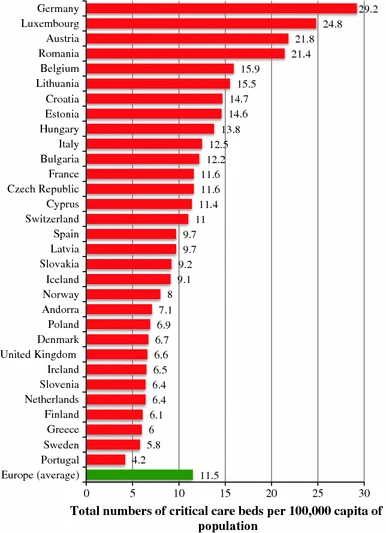
1.5 Coping with an Earlier Crisis
In dealing with the H1N1 pandemic in 2009 Sweden wanted to be precautious. A very high coverage of vaccination among the citizens was reached by convincing people to show solidarity with risk groups. Convincing the people worked out well due to the high trust in authorities as well as the health care system. As the vaccine also had negative side effects, the Swedish response was only partly assessed as being successful (Giritli Nygren & Olofsson, 2020). [18]
The current response to covid-19 differs a lot from the reponse to H1N1, as Sweden this time did not take very strong measures and yet there is no vaccination available. But the approach of relying on the citizens responsibility can also be recognized during covid-19.
The current response to covid-19 differs a lot from the reponse to H1N1, as Sweden this time did not take very strong measures and yet there is no vaccination available. But the approach of relying on the citizens responsibility can also be recognized during covid-19.
2 Sense-making
2.1 COVID-19 Cases
The first case of covid-19 was confirmed in Sweden on 1 February. The number of cases constantly increased and especially since the beginning of June there were lots of new confirmed cases, whereas in its Scandinavian neighbouring countries like Norway the numbers already decreased. [19]
The number of confirmed covid-19 cases in Sweden constantly grew up to more than 65000 cases overall in the end of June. This number is much higher than the number of the other Scandinavian countries. [20] This is also due to the fact that Sweden has 10 million inhabitants and therefore nearly twice as much as Denmark (5,9), Finland (5,5) and Norway (5,4). [21] But still the number of cumulative confirmed cases per million people is still much higher. [22] [23] Along with countries like Brazil and Chile Sweden is internationally known for having a very high number of cases.
The number of confirmed covid-19 cases in Sweden constantly grew up to more than 65000 cases overall in the end of June. This number is much higher than the number of the other Scandinavian countries. [20] This is also due to the fact that Sweden has 10 million inhabitants and therefore nearly twice as much as Denmark (5,9), Finland (5,5) and Norway (5,4). [21] But still the number of cumulative confirmed cases per million people is still much higher. [22] [23] Along with countries like Brazil and Chile Sweden is internationally known for having a very high number of cases.
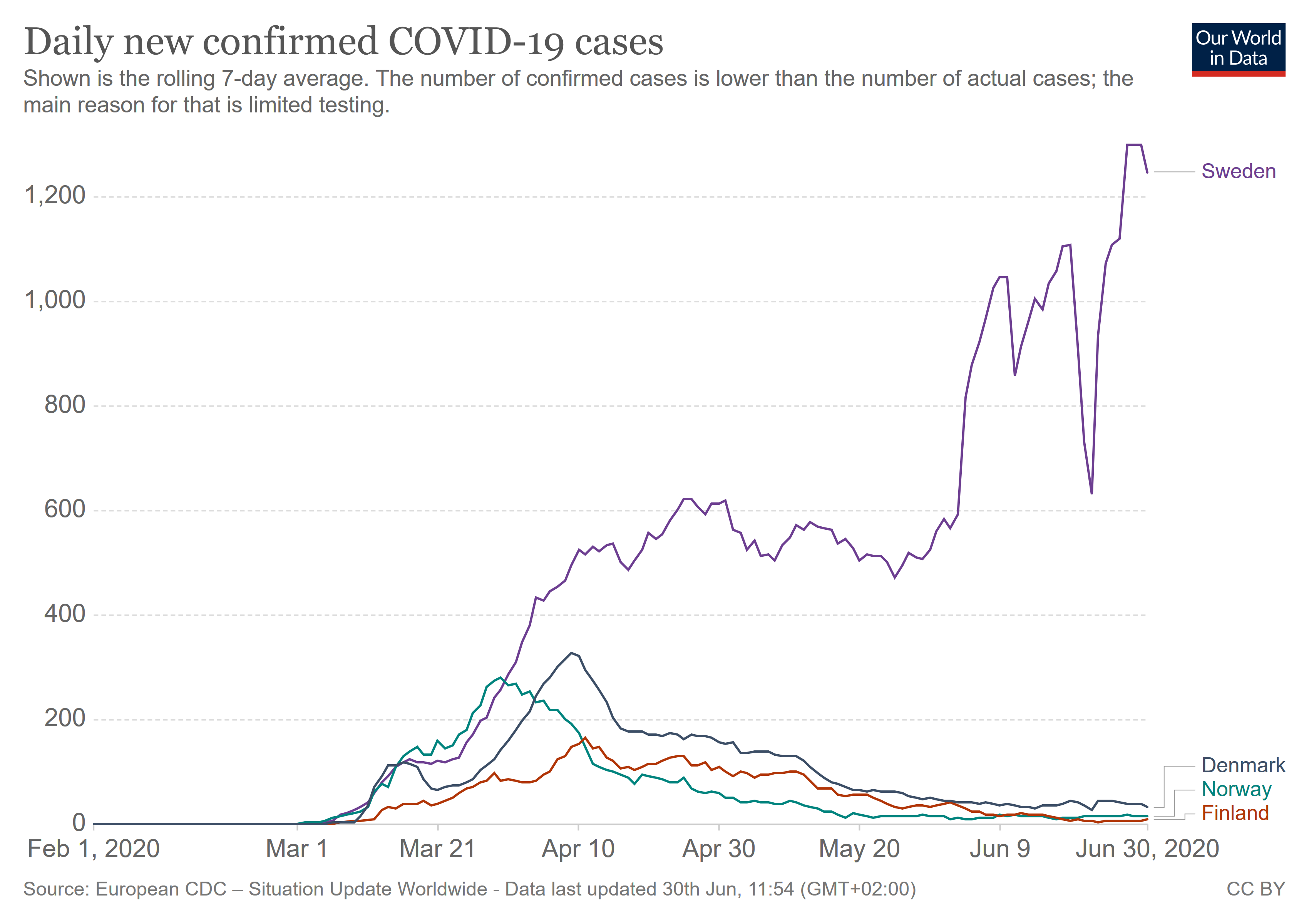
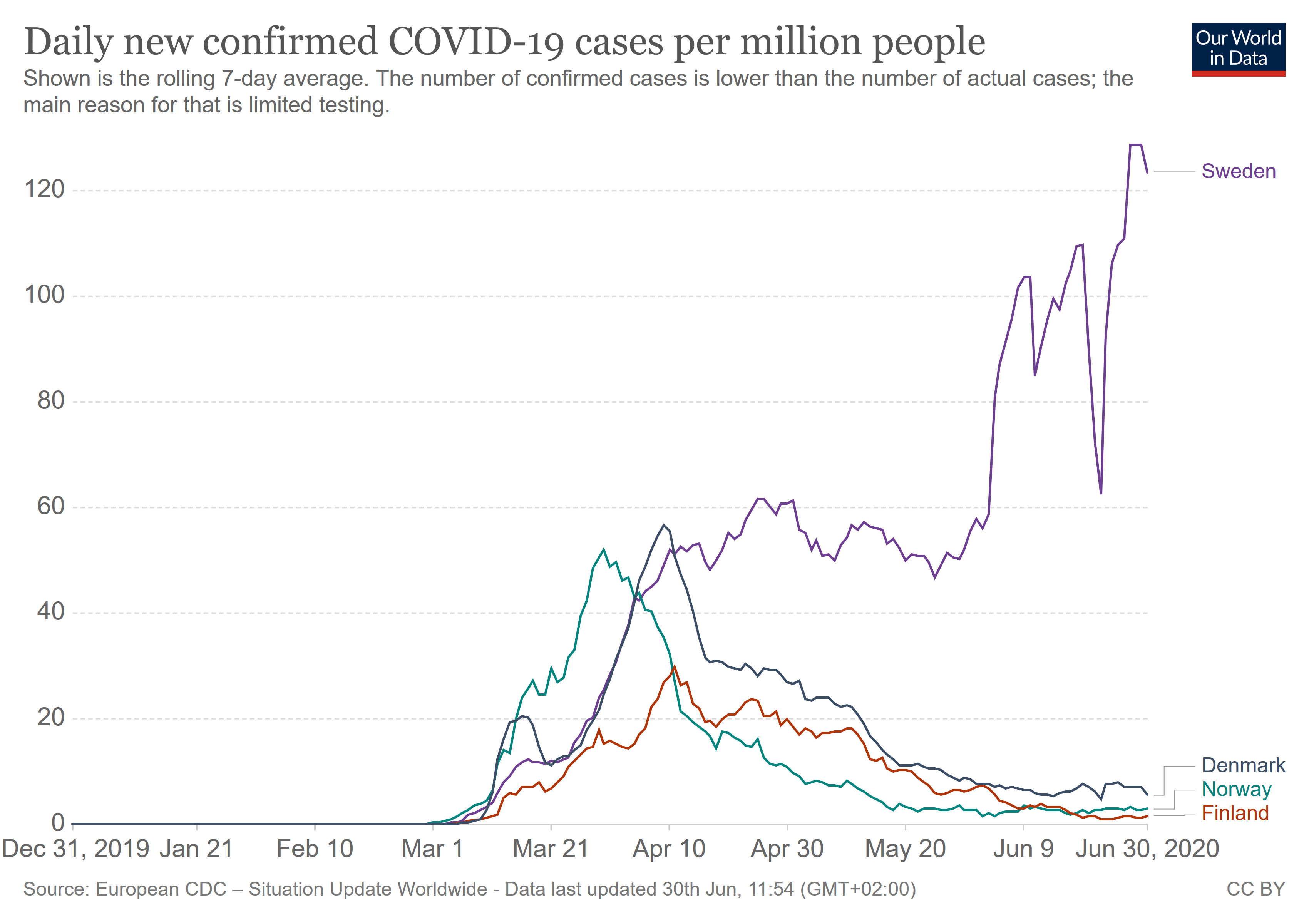
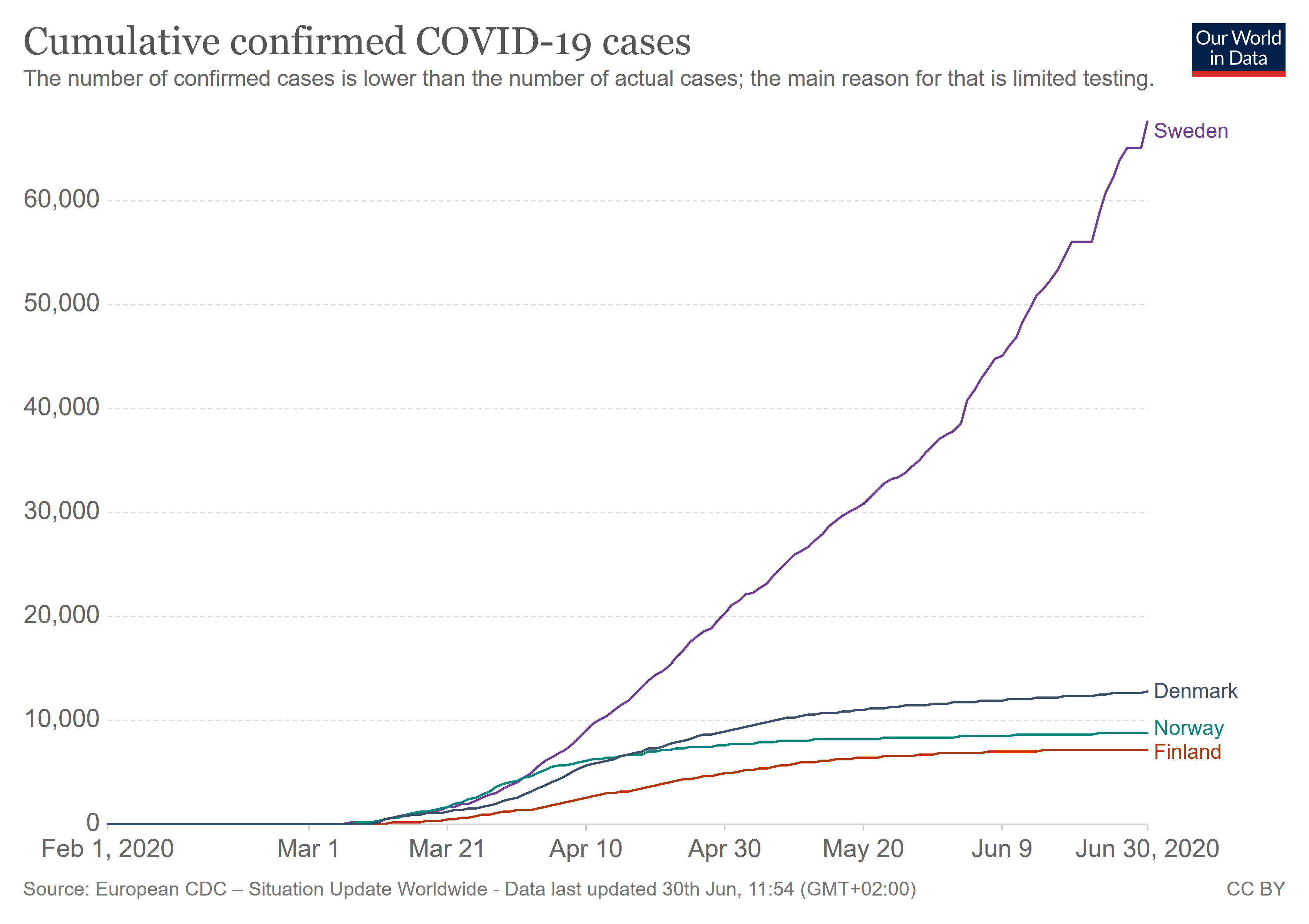
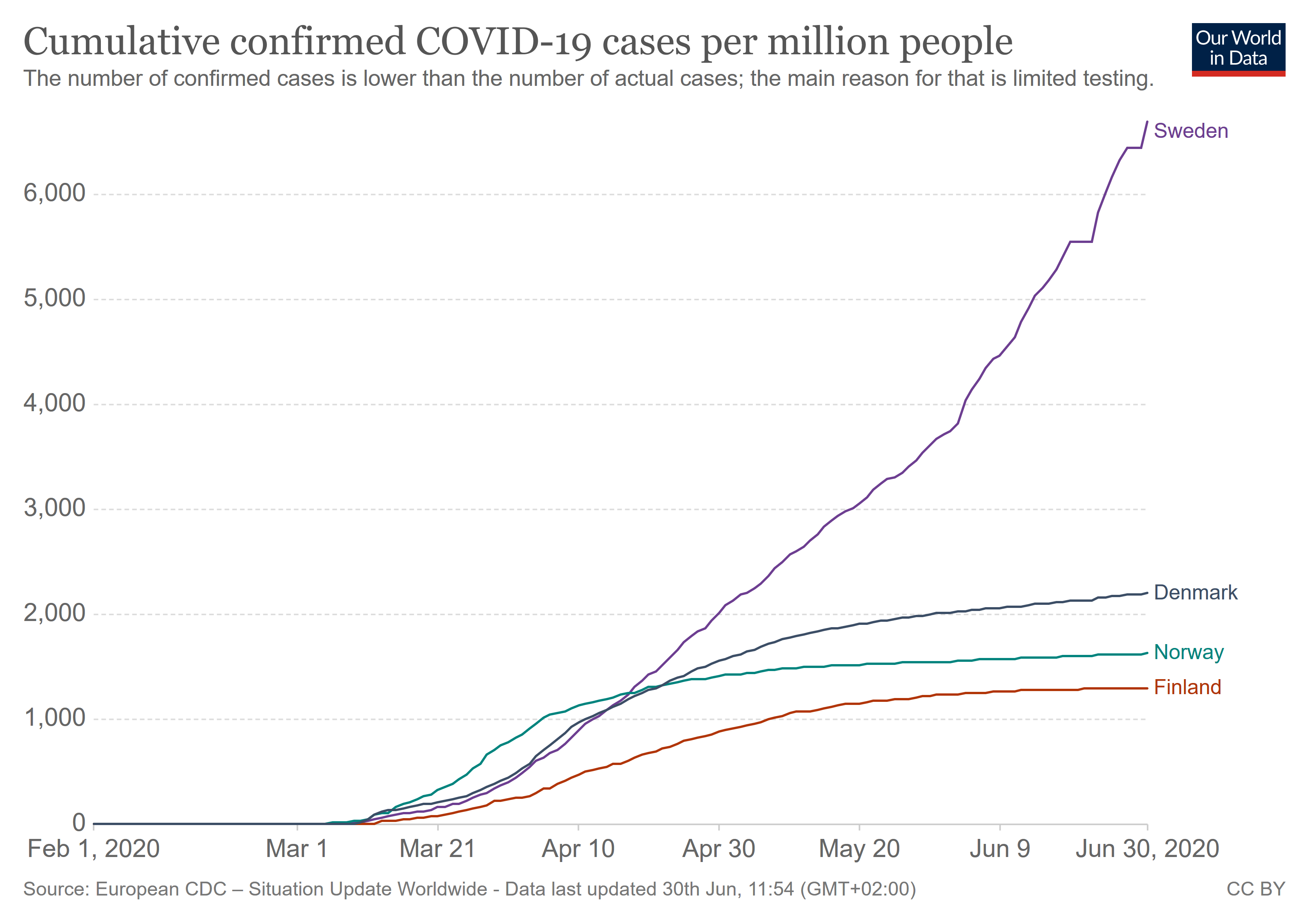
2.2 COVID-19 Deaths
The first death due to covid-19 was reported on 12 March. The number of deaths strongly increased until end of June when there were more than 100 deaths per day. Although the number of infections still rose in May and June, the number of deaths went down again. [24] [25]
Again, compared to the other Scandinavian countries like Norway the Swedish numbers are much higher. The case fatality rate, which is the ratio between deaths and cases, indicates that even this number in Sweden is much higher. [26] So in Sweden there is not just a higher number of infected people and therefore a proportionally larger number of deaths, the number of deaths is even higher in relation to the many confirmed cases. This implies that Sweden had more difficulties in curing infected people than its neighbouring countries.
Again, compared to the other Scandinavian countries like Norway the Swedish numbers are much higher. The case fatality rate, which is the ratio between deaths and cases, indicates that even this number in Sweden is much higher. [26] So in Sweden there is not just a higher number of infected people and therefore a proportionally larger number of deaths, the number of deaths is even higher in relation to the many confirmed cases. This implies that Sweden had more difficulties in curing infected people than its neighbouring countries.
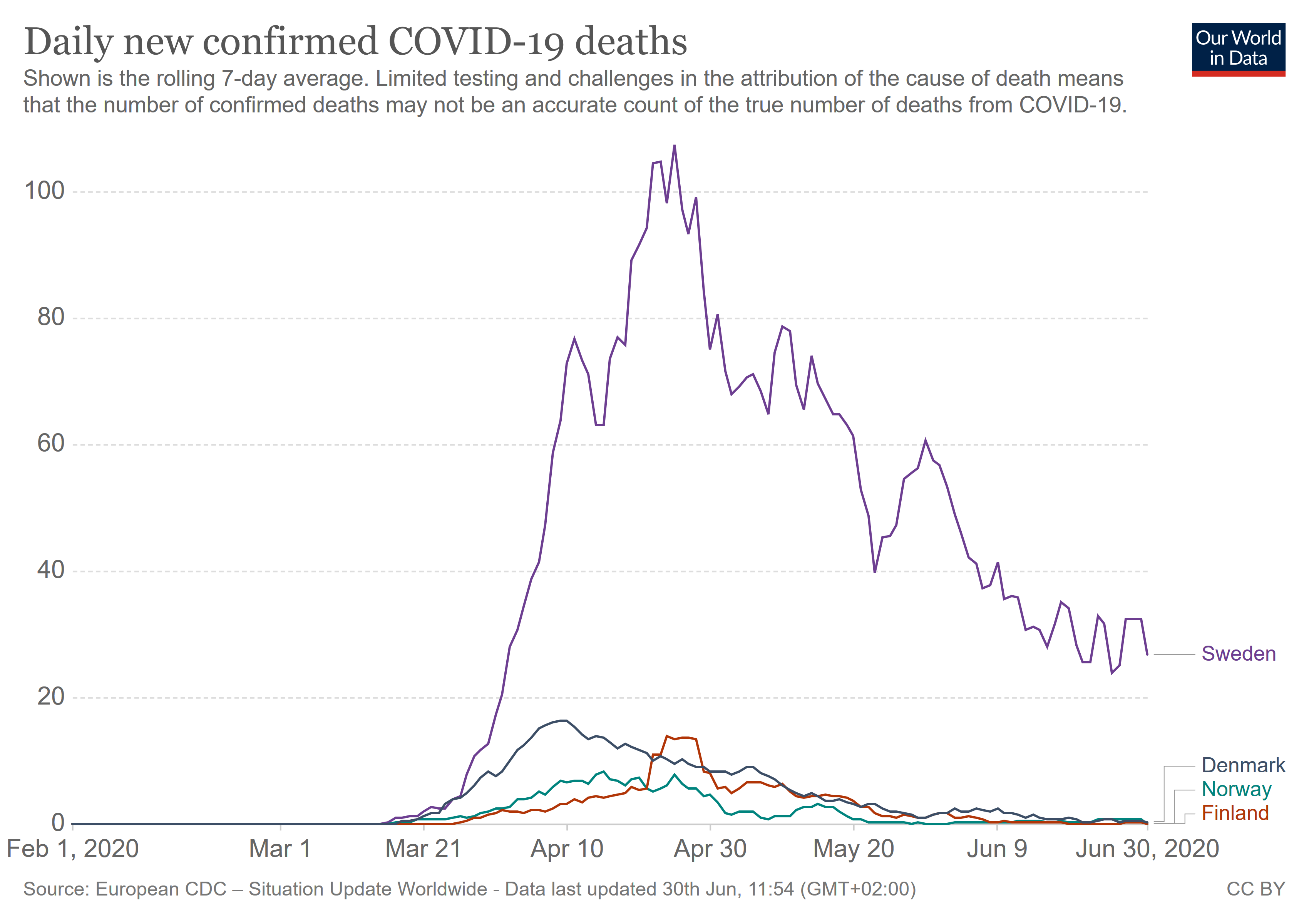
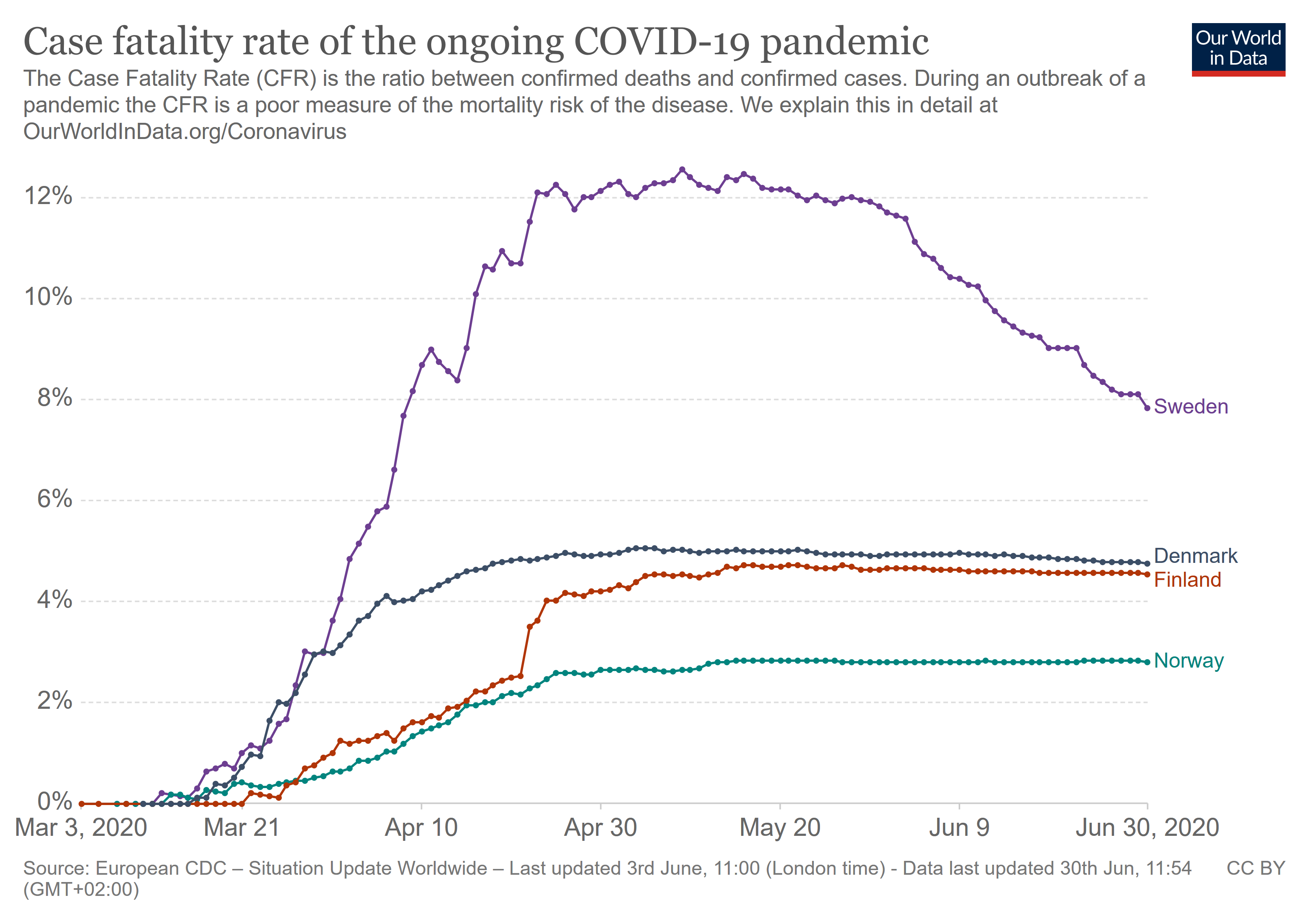
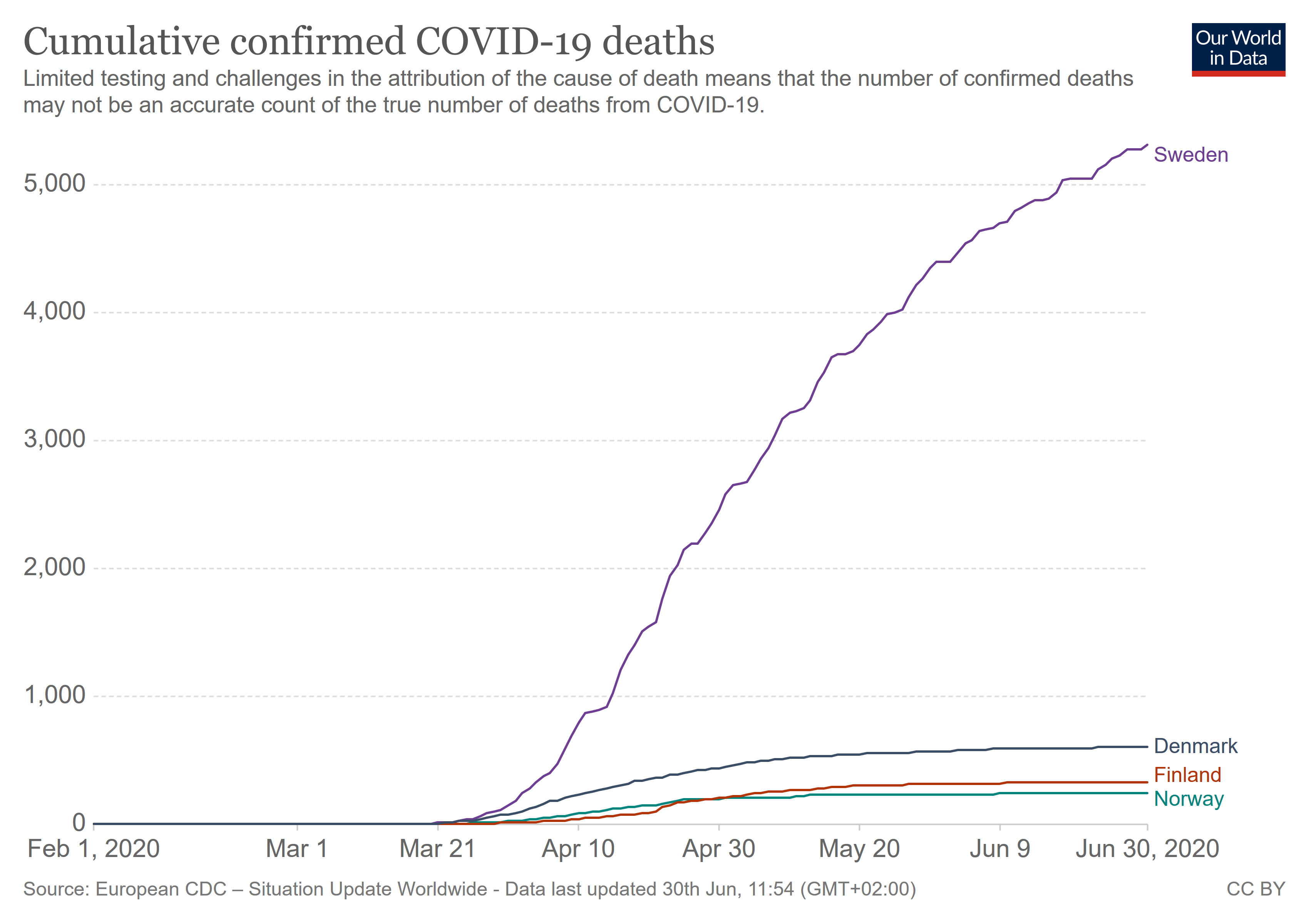
2.3 Testing
Until the beginning of June only people having symptoms and meeting specific criteria, for example hospital workers or people having contact to confirmed cases, were tested due to limited testing capacities. Since then at least anyone with symptoms was tested, [27] but still the width of testing is quite small. [28] The World Health Organisation (WHO) suggested 10 - 30 tests per confirmed case as an adequate number for efficient testing. If the number is too low, countries do not test widly enough for finding all cases. Since end of March the number of tests per confirmed case was permanent below 10. [29] The share of positive tests is the inverse way of reporting the width of testing. This number should be between 3% and 12% for adequate testing.
So especially in the middle of april, but also currently there should be more tests for getting a more realistic and complete statistic of confirmed cases. [30] Therefore the numbers of confirmed cases and deaths given above are likely to be underestimated.
With its low number of conducted tests per confirmed, Sweden is not an exception. For example Chile, Iran and India also have problems with testing widely enough. But of course there are also countries like Taiwan and Thailand, which manage proper testing well.
So especially in the middle of april, but also currently there should be more tests for getting a more realistic and complete statistic of confirmed cases. [30] Therefore the numbers of confirmed cases and deaths given above are likely to be underestimated.
With its low number of conducted tests per confirmed, Sweden is not an exception. For example Chile, Iran and India also have problems with testing widely enough. But of course there are also countries like Taiwan and Thailand, which manage proper testing well.
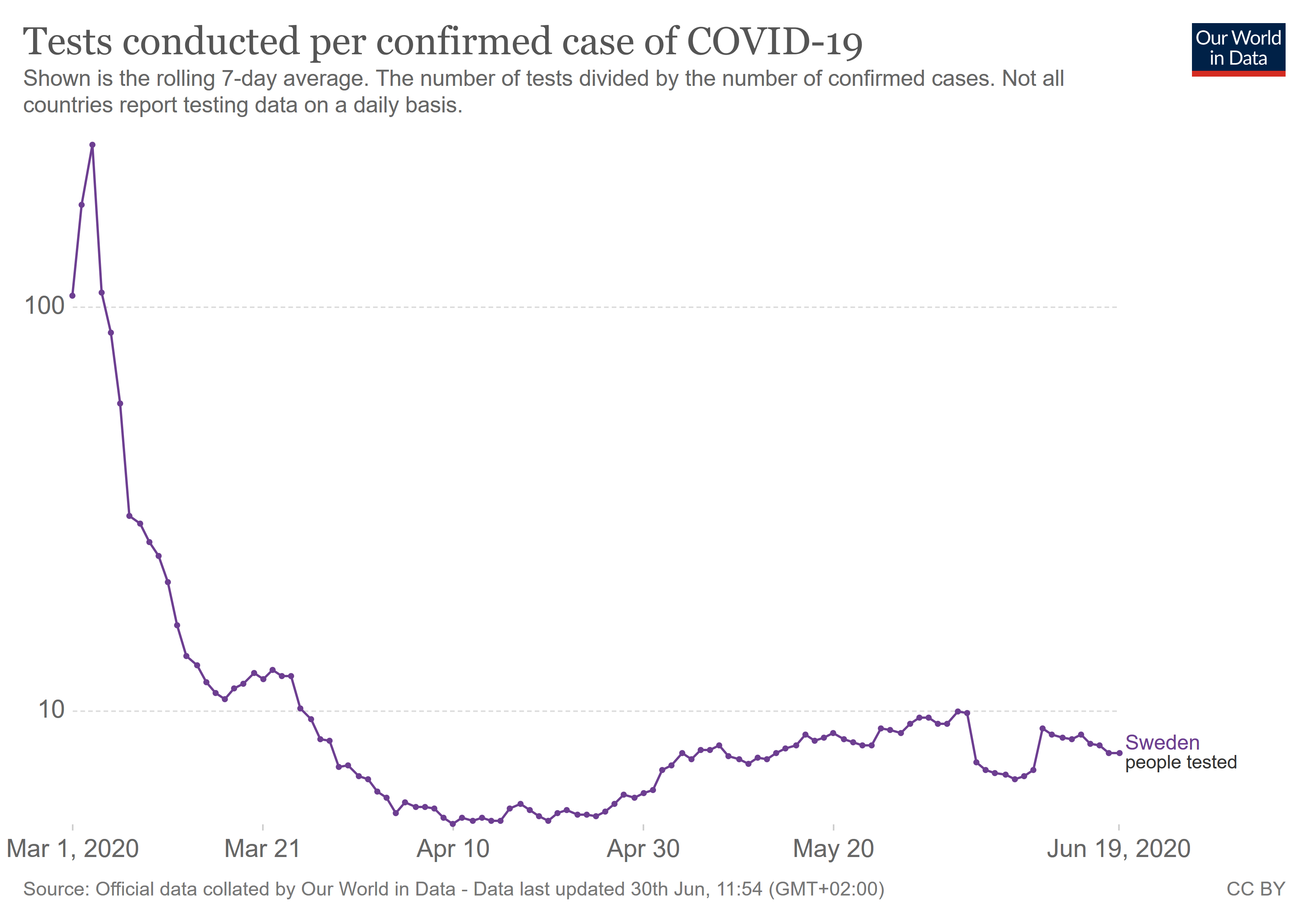
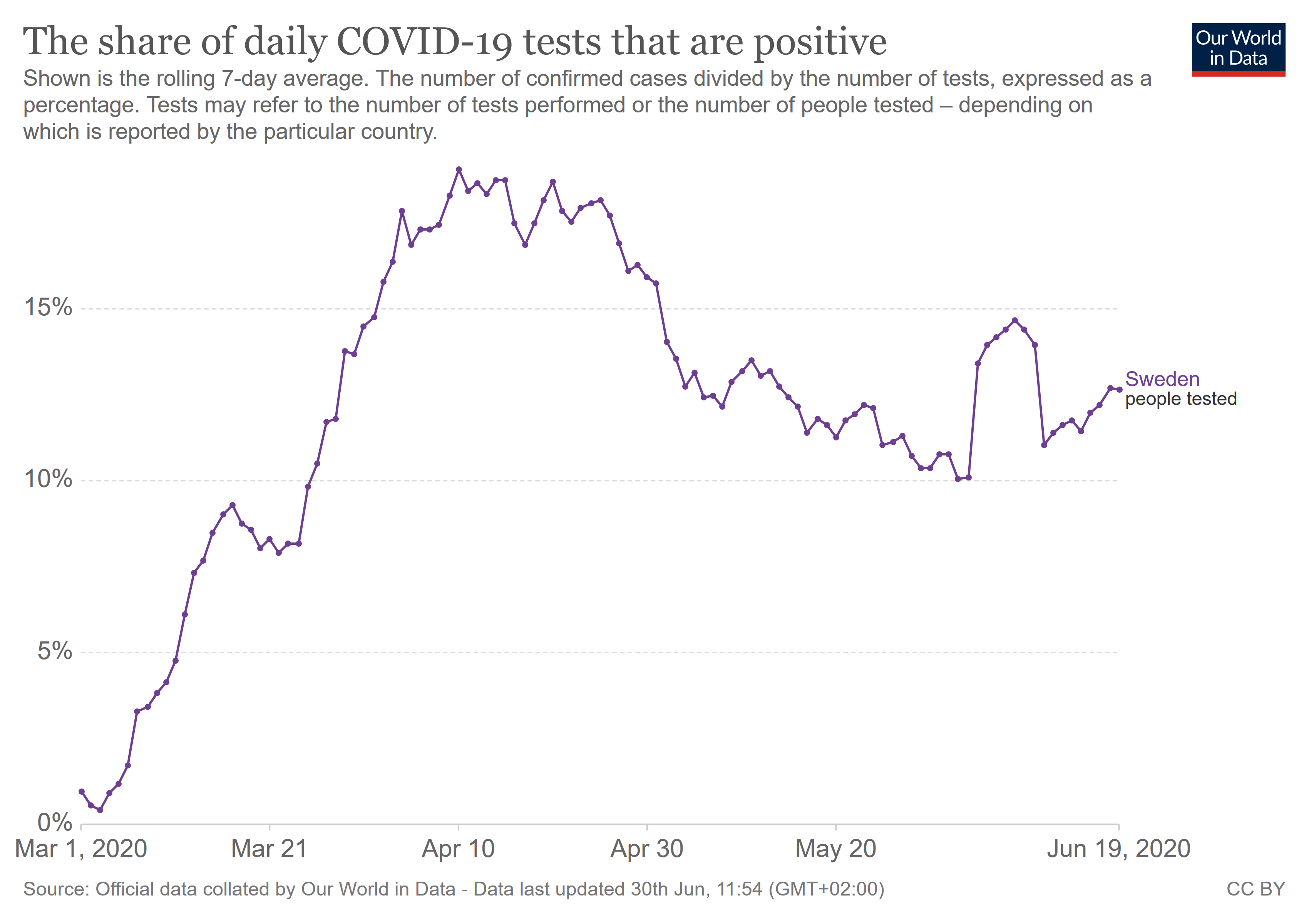
2.4 Reporting
In Sweden reporting of the situation is transparent. The authorities give daily updates about the current development of confirmed cases as well as confirmed deaths. In doing so, a case is counted if it is confirmed with a test in laboratory. Every person who died while being covid-19 positive is counted as a covid-19 death, regardless of the cause of death. [31]
3 Decision-making and Coordinating
3.1 Strategy
On 1 February when there was the first confirmed case in Sweden, the government declared covid-19 as "a disease that constitutes a danger to society, opening the possibility of extraordinary communicable disease control measures". [32] This classification under the terms of the Communicable Disease Act allows interventions such as quarantine and lockdown of areas. [33] In Sweden the seriousness of the situation was clarified to the citizens without dramatizing it by using metaphors of war like France and India did.
According to the government the aim in dealing with covid-19 is to:
According to the government the aim in dealing with covid-19 is to:
- "Limit the spread of infection in the country"
- "Ensure that health and medical care resources are available"
- "Limit the impact on critical services"
- "Alleviate the impact on people and business"
- "Ease concern"
- "Implement the right measures at the right time"
3.2 Measures
3.2.1 Restrictions and Recommendations
There were only a few binding restrictions released by the government. On 17 March travel to Sweden was limited. Since 29 March public gatherings with more than 50 people are prohibited, before that they were only limited to 500 people. Also there was issued a ban on vistiting care homes of older people for the 1 April. [34] [35]
Instead of restrictions by law the Public Health Agency gave several recommendations to the citizens. These include that citizens should realize good hygiene, keep physical distance to other people, avoid social gatherings and refrain from non-essential travel. People feeling ill should stay at home just as people over 70 years of age should do. Also people should work from home if possible and universities and high schools changed to teaching online. But unlike in other countries younger children still went to school and also shops and restaurants remained open all the time. [36]
Even though the numbers of cases constantly increased, Sweden maintained its very liberal strategy. A comparison with the Netherlands is very interesting. The Dutch approach was also very liberal, the focus was on recommendations and relying on the responsibility of the citizens. But when numbers of cases increased, they readjusted their strategy and implemented an "Intelligent Lockdown" to reduce the infections again. As opposed to the Netherlands, the Swedish authorities still believed in the liberal strategy and therefore did not change it.
In most countries dealing successfully with covid-19, there where much stricter measures than in Sweden. But there are also countries like Taiwan, which managed the crisis effectively without implementing very strict measures.
Instead of restrictions by law the Public Health Agency gave several recommendations to the citizens. These include that citizens should realize good hygiene, keep physical distance to other people, avoid social gatherings and refrain from non-essential travel. People feeling ill should stay at home just as people over 70 years of age should do. Also people should work from home if possible and universities and high schools changed to teaching online. But unlike in other countries younger children still went to school and also shops and restaurants remained open all the time. [36]
Even though the numbers of cases constantly increased, Sweden maintained its very liberal strategy. A comparison with the Netherlands is very interesting. The Dutch approach was also very liberal, the focus was on recommendations and relying on the responsibility of the citizens. But when numbers of cases increased, they readjusted their strategy and implemented an "Intelligent Lockdown" to reduce the infections again. As opposed to the Netherlands, the Swedish authorities still believed in the liberal strategy and therefore did not change it.
In most countries dealing successfully with covid-19, there where much stricter measures than in Sweden. But there are also countries like Taiwan, which managed the crisis effectively without implementing very strict measures.
3.2.2 Contact Tracing
The Public Health Agency defines contract tracing as "an investigation of how an infected person might have contracted the disease (e.g. COVID-19), including the identification of other people who may be infected or have been exposed to the virus". [37] In the beginning of the pandemic Sweden did comprehensive contact tracing, but since end of March they were only capable of limited contract tracing, which means only some of the confirmed cases are traced. [38] This limited contact tracing is opposite to the very comprehensive contract tracing, for example in Israel. Also Sweden did not develop a contact tracing app as other countries like South Korea, France and the Netherlands did.
3.2.3 Economic Impact
Covid-19 also had a big impact on the economy. The Swedish Ministry of Finance expects a decline in GDP by six percent. [39]
Sweden decided for several crisis packages and financial support in order to mitigate the negative economic effects. [40]
The measures concerning the private sector include the following:
Sweden decided for several crisis packages and financial support in order to mitigate the negative economic effects. [40]
The measures concerning the private sector include the following:
- With the aim of saving jobs, the state covers a large share of wage costs. Employees should still receive at least 90 percent of their wages.
- The state covers the costs of sick pay of April and May.
- Companies are allowed to defer the payment of contributions and taxes.
- The national level gives economic support to the regions and municipalities in order to compensate the extra costs in health care.
- Additional resources are given to agencies relevant in dealing with covid-19 such as the Public Health Agency
3.2.4 Subnational Levels
As Sweden is a decentralized country and the subnational levels have their own competencies, this suggest the assumption of decentralized measures. But finding corresponding information was very difficult. By looking at the regions and municipalties websites one can only find links to the governemental agencies advice. Therefore the Swedish subnational levels seem to completely rely on the national levels decisions. This is opposite to several other countries, for example Germany and India changed their original national strategy into a more decentralized and flexible one, where the subnational levels make their own decisions.
3.2.5 Additional Competences for the Government
On 16 April the Swedish parliament Riksdag passed a bill that enabled the government to adopt new measures faster. Between 18 April and 30 June the government was allowed to make decisions concerning the corona virus without having to wait for the vote in parliament. However parliament had the right to revoke the governments decisions afterwards. [41] [42]
This law was not an exception in Sweden, also other countries like Switzerland and Thailand implemented emergency laws in order to ensure fast decision making.
This law was not an exception in Sweden, also other countries like Switzerland and Thailand implemented emergency laws in order to ensure fast decision making.
3.2.6 Government Response Stringency Index
The Government Stringency Index states how strict the policy measures are, whereby 100 is the highest number. Sweden was quite constant at the level of 46 since beginning of April. This number was low compared to the other Scandinavian countries. But Sweden yet did not follow the other countries in easing the restrictions due to its still increasing number of cases. So at now Norway and Finland even achieve a lower score than Sweden. [43]
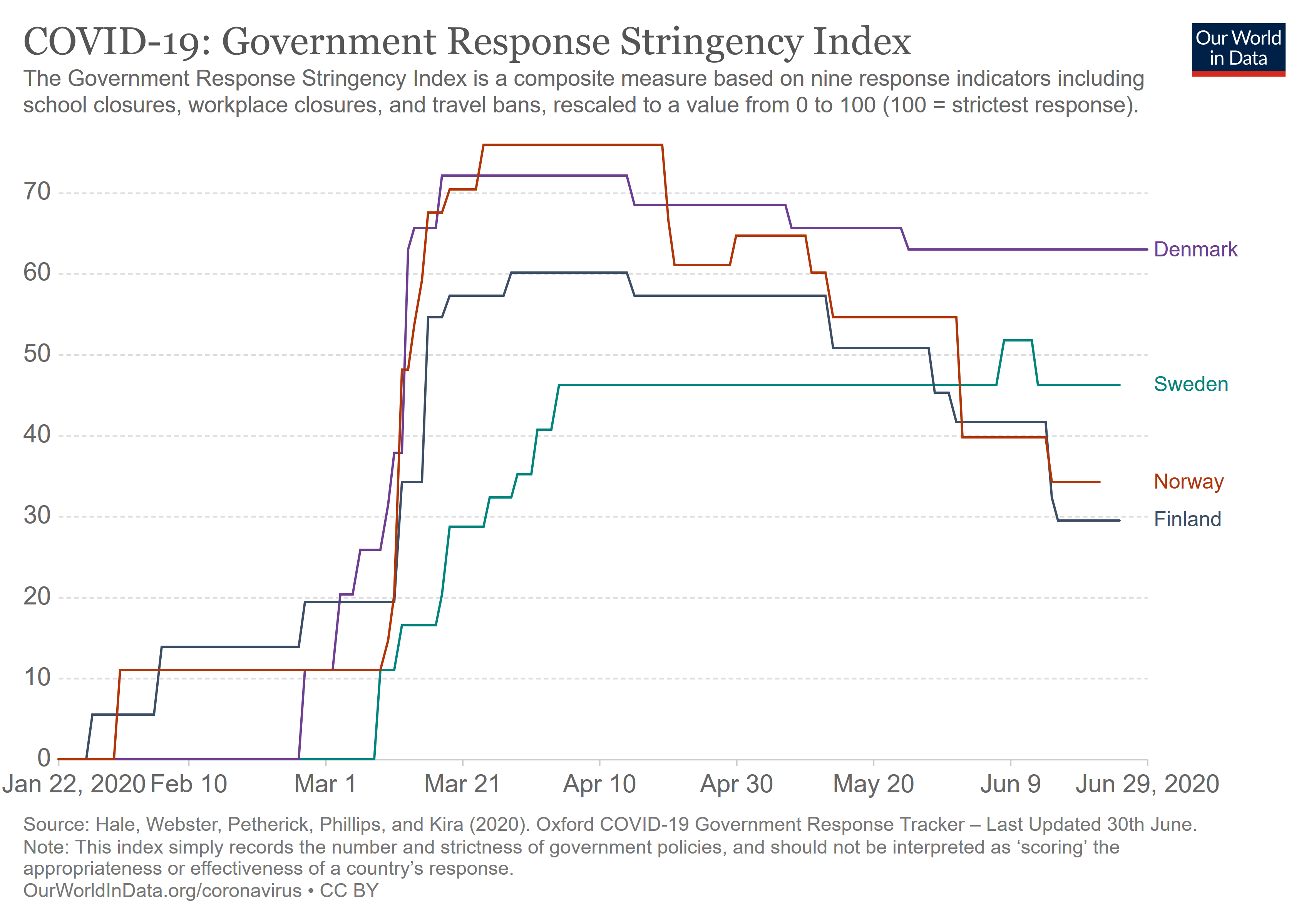
4 Legitimacy
The Swedish strategy in dealing with covid-19 is observed, debated, assessed and criticized a lot. The Swedish authorities justify their liberal strategy whereas scientists as well as the opposition parties are sceptical. Moreover the outstanding Swedish strategy is not only a domestic topic, but internationally traced.
4.1 Criticism
4.1.1 Experts
Since the beginning of the pandemic there has been a heavy debate about whether the Swedish strategy is adequate. Many scientists were worried that the Swedish strategy is not strict enough. More than 2000 scientists and doctors signed a petition calling the government to issue stricter measures and to "immediately take steps to comply with the World Health Organization's recommendations." They criticized that there was not enough testing, tracing and isolating. [44] [45]
Also the former state epidemiologist Annika Linde criticised the Swedish strategy. Although she had first supported the strategy, in the end of March she declared that a lock down could have prevented deaths. Especially she criticizes that some earlier top-controll in care homes for older people could have saved many lives. [46]
Also the former state epidemiologist Annika Linde criticised the Swedish strategy. Although she had first supported the strategy, in the end of March she declared that a lock down could have prevented deaths. Especially she criticizes that some earlier top-controll in care homes for older people could have saved many lives. [46]
4.1.2 Opposition
As well as many scientists, the opposition parties criticize the govermment's response more and more. They blamed the government for not having the situation under control and claimed the government made decisions too slow and with serious errors. [47]
4.1.3 Public Opinion
Similarly to the division in science and politics, also the public opinion about the Swedish strategy is very divided. [48] The percentage of people thinking that the government handles the crisis well was 40% in the middle of March. The number increased until its maximum point of 64% was reached in the middle of May. Until middle of June the number decreased again to 46%. The percentage of people having confidence in the health authorities was larger than the one in the government. But still at all time the Swedish confidence in their government and health authorities was lower than the one of the other Scandinavian countries like Norway. The fact that the Swedish government is claiming generally "people in Sweden have a high level of trust in government agencies" seems not be very applicable for the time of the covid-19 pandemic. [49] .
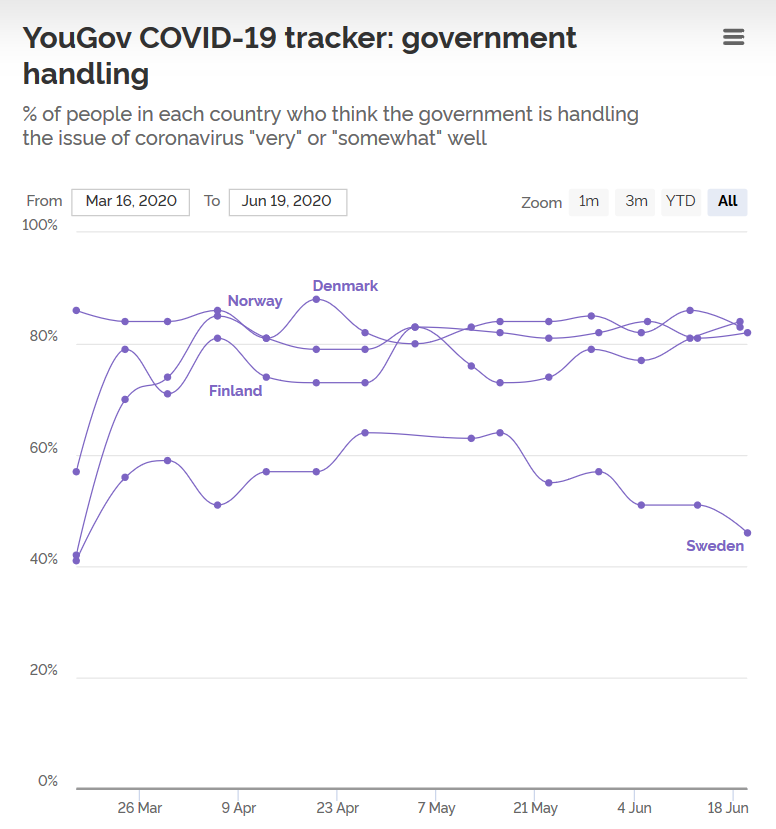
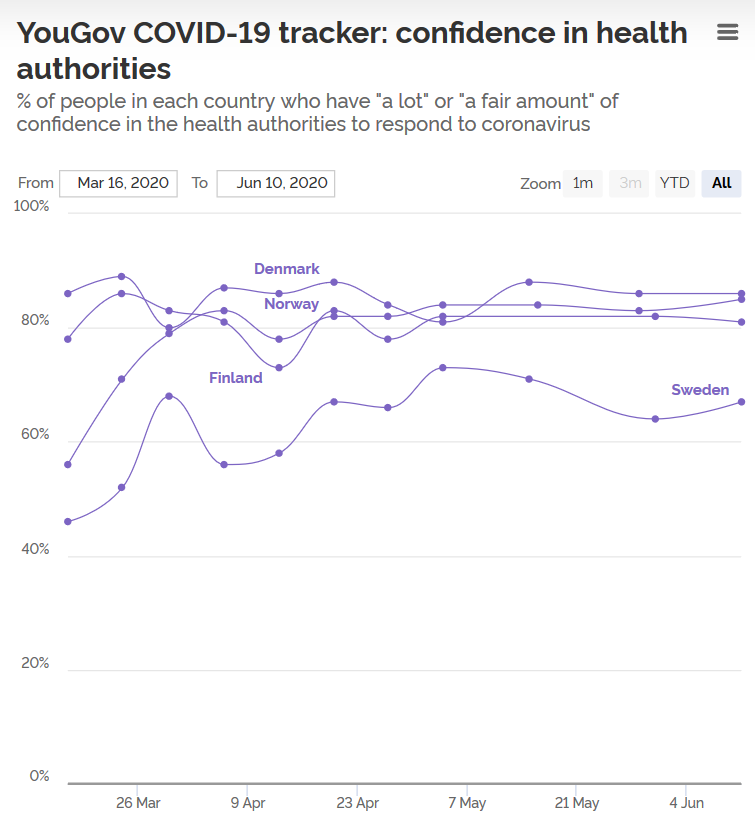
4.1.4 International Level
Not only within Sweden, but also on the international level the Swedish strategy was traced a lot. In the beginning of the pandemic it was often referred to as being a big experiment with an unknown outcome. The main question was whether Sweden will count as a good example or whether the liberal stratgy will end in a disaster. [50]
There has always been some scepticism, but especially under the latest developments - still increasing number of cases in Sweden whereas the number already decreased in other countries - the critique clearly dominates. On 25 June the WHO classified Sweden as one out of eleven countries, which in "accelerated transmission has led to very significant resurgence that if left unchecked will push health systems to the brink once again in Europe." [51] Also several countries such as Germany published warnings about traveling to Sweden [52]
So the Swedish authorities do not only have to justify their handling with covid-19 towards their own population, but also on the international level. This is due to the fact that a communicable disease can not be prevented from spreading over national boarders, and therefore also other countries are clearly interested in the decrease of numbers in Sweden.
There has always been some scepticism, but especially under the latest developments - still increasing number of cases in Sweden whereas the number already decreased in other countries - the critique clearly dominates. On 25 June the WHO classified Sweden as one out of eleven countries, which in "accelerated transmission has led to very significant resurgence that if left unchecked will push health systems to the brink once again in Europe." [51] Also several countries such as Germany published warnings about traveling to Sweden [52]
So the Swedish authorities do not only have to justify their handling with covid-19 towards their own population, but also on the international level. This is due to the fact that a communicable disease can not be prevented from spreading over national boarders, and therefore also other countries are clearly interested in the decrease of numbers in Sweden.
4.2 Justification of the Swedish Strategy
Swedens comparatively liberal measures were justified with having high trust in the citizens' responsibility. However the aim in dealing with the pandemic seems quite ambivalent. On the one hand, Swedish authorities claimed that they want to limit the spread of the virus and consequently denied that achieving herd immunity is the aim. But on the other hand they made a guess that Sweden could deal better with a second wave, because many people already have been exposed to the virus. [53]
The Swedish authorities always defended their stategy, however in the course of the pandemic the responsible stakholders became less confident about the Swedish strategy. In beginning of June the state epidemiologist Anders Tegnell admitted “There is potential for improvement in what we have done in Sweden, quite clearly.” But despite the heavy public criticism about the liberal strategy, he declared “We basically still think that this is the right strategy for Sweden that we are doing.” [54]
The Swedish authorities always defended their stategy, however in the course of the pandemic the responsible stakholders became less confident about the Swedish strategy. In beginning of June the state epidemiologist Anders Tegnell admitted “There is potential for improvement in what we have done in Sweden, quite clearly.” But despite the heavy public criticism about the liberal strategy, he declared “We basically still think that this is the right strategy for Sweden that we are doing.” [54]
5 Overall evaluation
5.1 Concerning the Literature
According to Boin et al. (2017) [55] a crisis is defined by the three main components uncertainty, threat and urgency.
For successful dealing with a crisis they defined five tasks of strategic leadership:
For successful dealing with a crisis they defined five tasks of strategic leadership:
5.1.1 Sense Making
Collecting information about the emerging crisis is the first step. The crisis must be identified and its extent must be recognized.
Due to the fact that the virus first occured in China, other countries had been aware of the threat even before the first case in their own country occured. Information was provided by supranational institutions such as the European Centre for Disease Prevention and Control (ECDC) and the World Health Organisation (WHO). Therefore Sweden soon was aware of the threat and declared covid-19 immediately as a great danger, when the first case was confirmed in Sweden.
Due to the fact that the virus first occured in China, other countries had been aware of the threat even before the first case in their own country occured. Information was provided by supranational institutions such as the European Centre for Disease Prevention and Control (ECDC) and the World Health Organisation (WHO). Therefore Sweden soon was aware of the threat and declared covid-19 immediately as a great danger, when the first case was confirmed in Sweden.
5.1.2 Decision Making and Coordinating
Given the uncertainty of a crisis it is very difficult to make decisions. Nevertheless the decisions should be made and implemented quickly to overcome the threat.
The responsible stakeholders in Sweden soon agreed on the liberal response, which was maintained over time. The coordination between those responsible seemed to be functioning. Also implementation of the few restrictions of the government worked out, as well as the implementation of the recommendations by the Public Health Agency.
The responsible stakeholders in Sweden soon agreed on the liberal response, which was maintained over time. The coordination between those responsible seemed to be functioning. Also implementation of the few restrictions of the government worked out, as well as the implementation of the recommendations by the Public Health Agency.
5.1.3 Meaning Making
Leaders need to offer a definition of the situation and a convincing narrative to the public.
Sweden tried to create a collective feeling by stating that it is only possible to overcome the crisis together. Also the Swedish authorities pointed out the individual responsibility every citizen has. Already in the beginning of the crisis this narrative only worked out to some extent, because many people were not optimistic about the success of the Swedish stategy. Especially when the number of cases increased the narrative was not convincing anymore.
Sweden tried to create a collective feeling by stating that it is only possible to overcome the crisis together. Also the Swedish authorities pointed out the individual responsibility every citizen has. Already in the beginning of the crisis this narrative only worked out to some extent, because many people were not optimistic about the success of the Swedish stategy. Especially when the number of cases increased the narrative was not convincing anymore.
5.1.4 Accounting
Particularly in democraticies such as Sweden it is important to give explanations and justify what is done in dealing with the crisis.
Due to the fact that the Swedish strategy was very controversial, the authorities had to justify their approach a lot. Making political decisions is always about weighing up possibilities. In the case of covid-19 it was a weighing between individual freedoms and the security of people. The Swedish authorities hoped that their liberal strategy would still work out in saving lives. But as one can see in international comparison, having stricter measures -especially in the beginning- lead to lower cases in average.
Due to the fact that the Swedish strategy was very controversial, the authorities had to justify their approach a lot. Making political decisions is always about weighing up possibilities. In the case of covid-19 it was a weighing between individual freedoms and the security of people. The Swedish authorities hoped that their liberal strategy would still work out in saving lives. But as one can see in international comparison, having stricter measures -especially in the beginning- lead to lower cases in average.
5.1.5 Learning
Learning is about the evaluation of the crisis management. Due to the fact that the crisis is still ongoing in Sweden and so far no one knows what would have been the most effective response, this process has not taken place yet.
5.2 Conclusion
All in all, Sweden was early aware of the threat and soon decided on a strategy. The open question remains, whether this strategy was adequate.
The high numbers of infections show, that the attempt to minimize the spread of the virus by recommendations was not as successful as the binding restrictions in other countries.
Having very strict restrictions in the beginning of the pandemic limited the spread in many other countries like Norway already in early stages. Therefore they are now able to ease some of the restrictions, whereas Sweden still has to maintain most of its recommendations. Especially by looking at Swedens good resources, the numbers of cases and deaths seem surprisingly high.
Of course one can argue, that it was most important that the Swedish citizens kept most of their civil liberties during the crisis.
But since the long-term concequences of covid-19 are still unknown and the speculations of immunity after being being cured could not be confirmed, the strategy was very risky. Giving the responsibility to the citizens was a justifiable attempt. But after the ongoing increase of cases the demand for a change in the strategy and having stricter measures got stronger. Especially the protection of risk groups such as the elderly should have done more extensively.
The high numbers of infections show, that the attempt to minimize the spread of the virus by recommendations was not as successful as the binding restrictions in other countries.
Having very strict restrictions in the beginning of the pandemic limited the spread in many other countries like Norway already in early stages. Therefore they are now able to ease some of the restrictions, whereas Sweden still has to maintain most of its recommendations. Especially by looking at Swedens good resources, the numbers of cases and deaths seem surprisingly high.
Of course one can argue, that it was most important that the Swedish citizens kept most of their civil liberties during the crisis.
But since the long-term concequences of covid-19 are still unknown and the speculations of immunity after being being cured could not be confirmed, the strategy was very risky. Giving the responsibility to the citizens was a justifiable attempt. But after the ongoing increase of cases the demand for a change in the strategy and having stricter measures got stronger. Especially the protection of risk groups such as the elderly should have done more extensively.
5.3 Outlook
So far an end of the crisis is not forseeable in Sweden. The numbers of new infections are still high and therefore Sweden will need further time for the containment of the pandemic.
It seems likely that there will be a huge evaluation of the handling with the situation, in which the government has to justify the strategy even more than at the current time.
It seems likely that there will be a huge evaluation of the handling with the situation, in which the government has to justify the strategy even more than at the current time.
6 Favourite stay at home song
Sweden seems not to have developed a strong "stay at home culture", at least it is very difficult to find a corresponding song, that was viewed by many people.
The most watched Swedish songs that refer to covid-19 are satirical ones about the Swedish stategy in dealing with the virus, such as this one:
The most watched Swedish songs that refer to covid-19 are satirical ones about the Swedish stategy in dealing with the virus, such as this one:
https://www.youtube.com/watch?v=NTmInsHC6pg
[1] Government Offices of Sweden, https://www.government.se/how-sweden-is-governed/swedish-legislation---how-laws-are-made/, accessed at 16.06.2020
[2] Swedish Institute, https://sweden.se/society/political-parties-in-sweden/, acessed at 16.06.2020
[3] Government Offices of Sweden, https://www.government.se/how-sweden-is-governed/public-agencies-and-how-they-are-governed/, accessed at 16.06.2020
[4] Government Offices of Sweden, https://www.government.se/how-sweden-is-governed/the-swedish-model-of-government-administration/, acessed at 03.07.2020
[5] Swedish Association of Local Authorities and Regions, https://skr.se/tjanster/englishpages/municipalitiesandregions/localselfgovernment.1305.html, acessed at 03.07.2020
[6] Swedish Civil Contingencies Agency, https://www.krisinformation.se/detta-gor-samhallet/mer-om-sveriges-krishanteringssystem/krishanteringens-grunder, accessed at 11.07.2020 (translated by Google)
[7] Government Offices of Sweden, https://www.government.se/articles/2020/04/strategy-in-response-to-the-covid-19-pandemic/, accessed at 11.07.2020
[8] Public Health Agency of Sweden, https://www.folkhalsomyndigheten.se/the-public-health-agency-of-sweden/, accessed at 22.06.2020
[9] Public Health Agency of Sweden, https://www.folkhalsomyndigheten.se/the-public-health-agency-of-sweden/communicable-disease-control/surveillance-of-communicable-diseases/, accessed at 22.06.2020
[10] Government Offices of Sweden, https://www.government.se/articles/2020/04/strategy-in-response-to-the-covid-19-pandemic/, accessed at 16.07.2020
[11] National Board of Health and Welfare, https://www.socialstyrelsen.se/en/about-us/emergency-preparedness/the-role-of-the-national-board-of-health-and-welfare-during-the-covid-19-response-in-sweden/, accessed at 10.07.2020
[12] Swedish Civil Contingencies Agency, https://www.msb.se/en/operations/ongoing-operations/coronavirus---covid-19/what-does-msb-do/, accessed at 10.07.2020
[13] Organisation for Economic Cooperation and Development, http://www.oecd.org/health/sweden-has-excellent-health-care-but-must-improve-care-co-ordination.htm, accessed at 03.07.2020
[14] Swedish Institute, https://sweden.se/society/health-care-in-sweden/, accessed at 03.07.2020
[15] World Health Organization, https://apps.who.int/gho/data/node.main.GHEDCHEGDPSHA2011, accessed at 03.07.2020
[16] Global Health Security Index, https://www.ghsindex.org/country/sweden/, accessed at 16.06.2020
[17] Rhodes, A., P. Ferdinande, H. Flaatten, B. Guidet, P. G. Metnitz, and R. P. Moreno. 2012. “The variability of critical care bed numbers in Europe.” Intensive care medicine 38 (10): 1647–53. DOI:10.1007/s00134-012-2627-8
[18] Giritli Nygren, Katarina, and Anna Olofsson. 2020. “Managing the Covid-19 pandemic through individual responsibility: the consequences of a world risk society and enhanced ethopolitics.” Journal of Risk Research: 1–5. DOI: 10.1080/13669877.2020.1756382
[19] Our World in Data, https://ourworldindata.org/coronavirus-data-explorer?time=2020-02-01..&casesMetric=true&dailyFreq=true&smoothing=7&country=SWE~NOR~FIN~DNK&pickerMetric=location&pickerSort=asc, accessed at 30.06.2020
[20] Our World in Data, https://ourworldindata.org/coronavirus-data-explorer?casesMetric=true&totalFreq=true&smoothing=0&country=SWE~NOR~FIN~DNK&pickerMetric=location&pickerSort=asc, accessed at 30.06.2020
[21] Worldometer, https://www.worldometers.info/population/europe/northern-europe/, 30.06.2020
[22] Our World in Data, https://ourworldindata.org/coronavirus-data-explorer?casesMetric=true&dailyFreq=true&perCapita=true&smoothing=7&country=SWE~NOR~FIN~DNK&pickerMetric=location&pickerSort=asc, accessed at 30.06.2020
[23] Our World in Data, https://ourworldindata.org/coronavirus-data-explorer?casesMetric=true&totalFreq=true&perCapita=true&smoothing=0&country=SWE~NOR~FIN~DNK&pickerMetric=location&pickerSort=asc, accessed at 30.06.2020
[24] Our World in Data, https://ourworldindata.org/coronavirus-data-explorer?deathsMetric=true&dailyFreq=true&smoothing=7&country=SWE~NOR~FIN~DNK&pickerMetric=location&pickerSort=asc, accessed at 30.06.2020
[25] Our World in Data, https://ourworldindata.org/coronavirus-data-explorer?deathsMetric=true&totalFreq=true&smoothing=0&country=SWE~NOR~FIN~DNK&pickerMetric=location&pickerSort=asc, accessed at 30.06.2020
[26] Our World in Data, https://ourworldindata.org/coronavirus-data-explorer?cfrMetric=true&dailyFreq=true&smoothing=7&country=SWE~NOR~FIN~DNK&pickerMetric=location&pickerSort=asc, accessed at 30.06.2020
[27] Public Health Agency of Sweden, https://www.folkhalsomyndigheten.se/smittskydd-beredskap/utbrott/aktuella-utbrott/covid-19/bekraftade-fall-i-sverige/, accessed at 07.07.2020 (translated by Google)
[28] Our World in Data, https://ourworldindata.org/policy-responses-covid, accessed at 30.06.2020
[29] Our World in Data, https://ourworldindata.org/coronavirus-data-explorer?yScale=log&testsPerCaseMetric=true&dailyFreq=true&smoothing=7&country=~SWE&pickerMetric=location&pickerSort=asc, accessed at 30.06.2020
[30] Our World in Data, https://ourworldindata.org/coronavirus/country/sweden?country=~SWE, accessed at 30.06.2020
[31] Public Health Agency of Sweden, https://www.folkhalsomyndigheten.se/smittskydd-beredskap/utbrott/aktuella-utbrott/covid-19/bekraftade-fall-i-sverige/, accessed at 07.07.2020 (translated by Google)
[32] Government Offices of Sweden, https://www.government.se/articles/2020/04/strategy-in-response-to-the-covid-19-pandemic/, 14.06.2020
[33] Public Health Agency of Sweden, https://www.folkhalsomyndigheten.se/the-public-health-agency-of-sweden/communicable-disease-control/covid-19/, accessed at 04.07.2020
[34] Government Offices of Sweden, https://www.government.se/articles/2020/04/s-decisions-and-guidelines-in-the-ministry-of-health-and-social-affairs-policy-areas-to-limit-the-spread-of-the-covid-19-virusny-sida/, accessed at 23.06.2020
[35] Swedish Civil Contingencies Agency, https://www.krisinformation.se/en/hazards-and-risks/disasters-and-incidents/2020/official-information-on-the-new-coronavirus/restriktioner-och-forbud, 12.07.2020
[36] Public Health Agency of Sweden, https://www.folkhalsomyndigheten.se/the-public-health-agency-of-sweden/communicable-disease-control/covid-19/, accessed at 23.06.2020
[37] Public Health Agency of Sweden, https://www.folkhalsomyndigheten.se/the-public-health-agency-of-sweden/communicable-disease-control/covid-19/, accessed at 10.07.2020
[38] Our World in Data, https://ourworldindata.org/grapher/covid-contact-tracing, accessed at 10.07.2020
[39] Government Offices of Sweden, https://www.government.se/press-releases/2020/06/some-signs-of-recovery-in-the-economy--but-situation-still-very-serious/, accessed at 12.07.2020
[40] Government Offices of Sweden, https://www.government.se/press-releases/2020/03/crisis-package-for-swedish-businesses-and-jobs/, accessed at 12.07.202
[41] Government Offices of Sweden, https://www.government.se/articles/2020/04/s-decisions-and-guidelines-in-the-ministry-of-health-and-social-affairs-policy-areas-to-limit-the-spread-of-the-covid-19-virusny-sida/, accessed at 22.06.2020
[42] The Local, https://www.thelocal.se/20200408/explained-what-swedens-new-government-powers-actually-mean-in-practice, accessed at 22.06.2020
[43] Our World in Data, https://ourworldindata.org/coronavirus/country/sweden?country=~SWE, accessed at 30.06.2020
[44] CNN, https://edition.cnn.com/2020/04/28/europe/sweden-coronavirus-lockdown-strategy-intl/index.html, accessed at 22.06.2020
[45] The Guardian, https://www.theguardian.com/world/2020/mar/30/catastrophe-sweden-coronavirus-stoicism-lockdown-europe, accessed at 22.06.2020
[46] The Local, https://www.thelocal.se/20200528/annika-linde-coronavirus-a-little-humility-wouldnt-be-out-of-place-sweden-might-have-taken-some-wrong-turns, accessed at 22.06.2020
[47] Politico, https://www.politico.eu/article/swedes-turn-on-swedens-corona-response-coronavirus-covid19/, accessed at 22.06.2020
[48] YouGov, https://yougov.co.uk/topics/international/articles-reports/2020/03/17/perception-government-handling-covid-19, accessed at 30.06.2020
[49] Government Offices of Sweden, https://www.government.se/articles/2020/04/strategy-in-response-to-the-covid-19-pandemic/, accessed at 30.06.2020
[50] Financial Times, https://www.ft.com/content/31de03b8-6dbc-11ea-89df-41bea055720b, accessed at 29.06.2020
[51] World Health Organization, https://www.euro.who.int/en/media-centre/sections/statements/2020/statement-digital-health-is-about-empowering-people, accessed at 29.06.2020
[52] Federal Foreign Office Germany, https://www.auswaertiges-amt.de/de/aussenpolitik/laender/schweden-node/schwedensicherheit/210708, accessed at 29.06.2020
[53] Washington Post, https://www.washingtonpost.com/world/europe/sweden-epidemiologist-anders-tegnell/2020/06/03/063b20e4-a5a0-11ea-b619-3f9133bbb482_story.html, accessed at 23.06.2020
[54] CNN, https://edition.cnn.com/2020/04/28/europe/sweden-coronavirus-lockdown-strategy-intl/index.html, accessed at 23.06.2020
[55] Boin, Arjen, Paul ‘t Hart, Eric Stern, and Bengt Sundelius. 2016. “Managing Crises: Five Strategic Leadership Tasks.” In The Politics of Crisis Management: Public Leadership under Pressure, Cambridge: Cambridge University Press. chapter, 3–22. DOI: https://doi.org/10.1017/9781316339756.002